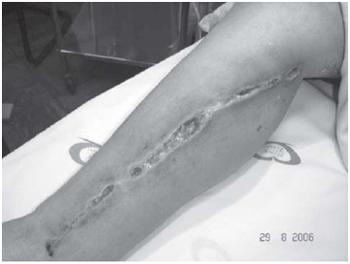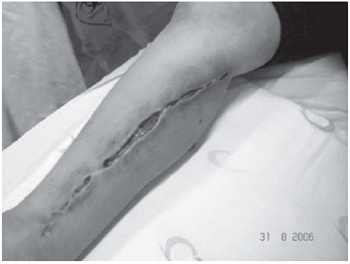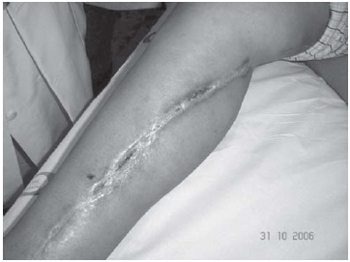Dehiscence is a feared complication after major surgeries. Patient who had undergone coronary artery bypass grafting developed saphenectomy's dehiscence on lower limb with edema and pain on the 15
postoperative day. Conventional treatment had been initially performed without clinical improvement. On the 30
postoperative day only Low Level Laser Therapy (LLLT) was applied punctually around surgical wounds edge. The results revealed granulated tissue, reduction of inflammatory process and analgesic effect since the first application. In this pilot study, LLLT has shown a considerable role as a wound healing agent, through a new proposal for efficient, safe and noninvasive therapy.
Deiscência é uma complicação temida em cirurgias de grande porte. Paciente submetida a revascularização miocárdica evoluiu com deiscência de safenectomia em membro inferior, edema e dor no 15º dia pós-operatório (PO), tendo sido realizado inicialmente o tratamento convencional no ambulatório sem melhora clínica. No 30º PO, aplicou-se somente Laser de Baixa Intensidade (LBI) ao redor da borda da ferida, pontualmente. A lesão respondeu com tecido de granulação, diminuição do processo inflamatório e analgesia desde a primeira aplicação. Neste estudo piloto, a laserterapia mostrou ter um papel importante como agente facilitador de cicatrização, por meio de uma terapia nãoinvasiva, eficaz e segura.
INTRODUCTION
One of the successful treatment for ischemic heart disease is coronary artery bypass grafting (CABG), often using saphenous vein as a coronary graft. However, after the procedure of resection of the saphenous vein, postoperative complications (PO) may occur, with around 10% of the cases occurring with dehiscence, becoming a debilitating factor.
Studies performed in patients undergoing CABG showed that several factors are associated with morbidities, changing the normal process of healing. Among these, we can mention: diabetes mellitus (DM), hypertension (HBP), dyslipidemia (DLP), female, elderly and cardiopulmonary bypass (CPB) [1,2].
A non-invasive treatment to help with the closing of wounds by second intention, which has been raising increased interest in medicine and related areas, is the Low Level Laser Therapy (LLLT), or simply laser therapy. This new therapeutic modality has been used recently, due to its effective analgesic and anti-inflammatory action, helping in the process of tissue repair.
The principle involved is the photophysical-chemical effect, on which the laser light interacts biomolecularly, by means of bioelectric, bioenergy and biochemical cell processes [3,4]. The mechanism of action occurs due to biomodulation of the inflammatory process, since it interferes with the chemical mediators, inhibiting the synthesis of prostaglandins, promoting the stimulation of fibroblasts in surgical wound tissue repair [3,5].
Due to the lack of studies in the literature on the action of LLLT on postoperative dehiscence, the aim of this study was to evaluate the response of the laser therapy as a possible therapy in acute saphenectomy dehiscence post-CABG.
CASE REPORT
54-year-old female patient, with history of HBP, DLP and DM, underwent CABG through the saphenous vein bypass and CPB, evolving with dehiscence of the right lower limb (RLL) in the 15
th postoperative day, presenting edema and pain that worsened during deambulation, even under use of analgesics. The wound had been submitted to conventional treatment at the Curative Group, outpatiently (performing cleaning using saline solution (SS) at 0.9% and local use of calcium alginate, 2x/day), with unsatisfactory results. In the 30
th postoperative day the use of laser was chosen, by removing curative and sterilizing before the applications.
After the patient read and signed the written informed consent, the applications of LLLT were punctually applied around the edge of the surgical wound, maintaining an interval of 2 cm from each point, at the whole extent of the dehiscence, maintaining a distance of 0.5 cm away from the skin. The Diode Laser (DMC, Brazil) was used with the following parameters: λ = 685 nm, Fluency = 4.5J/cm2, P=20mW, and before the applications, measurements of the IL (cirtometry) were perfomed, with follow-up of the development of the area and wound depth. For evaluation of pain, Visual Analogue Scale (VAS) was used (in which zero indicated complete absence of pain and 10 representing unbearable pain).
There was no need for debridement at any time during treatment with LLLT but only covering with gauze and band before the patient was discharged from hospital and was asked her daily asepsis with SS at 0.9%.
Initially, even at the first week (Figure 1) two applications of LLLT were performed at interval of 48 hours (Figure 2), however, in subsequent weeks, the laser was applied only once a week until the total closure, without administration of any medicine.

Fig. 1 - Dehiscence of saphenectomy: before the 1st application of LLLT

Fig. 2 - Dehiscence of saphenectomy: two days after the 1st application of LLLT
This study was previously submitted to the Ethics Committee for Analysis of Research Projects-CAPPesq (InCor-HC/FMUSP), by receiving the consent through the research protocol SDC-2742/05/162 without any restriction.
RESULTS
During treatment with LLLT, the wound revealed growth of granulation tissue formation in all its extension and delimitation of borders, as well as decrease of fibrin, in addition to the involution of erythema and edema in RLL, resulting in healing of the wound in the 9th session (Figure 3).
Regarding the pain, before starting therapy (1st session), the level of intensity was 5 (EVA), and immediately after LLLT this level was reduced to 2. In the next session, the pain became and remained at zero, which favored deambulation.
DISCUSSION
The combination of extrinsic and intrinsic risk factors increase the chance of postoperative complications of CABG [1]. Among these we found the following: DM, age and CPB time [2]. In this case report, we also found a number of factors related to the presence of dehiscence, as the patient presented HBP, DM and DLP, which possibly contributed to raise the possibility of increased morbidity during the healing process and incurring in dehiscence. This complication in this type of surgery leads to a weakness in the patient's health condition, thus worsening his quality of life.
The time of CPB during CABG surgery was of 100 minutes, which may have contributed to difficult - in one way or another - the process of tissue repair, since articles in the literature report that it may interfere with wound healing [2].
Some studies - in situ and in animals - have been revealing the mechanisms of action of irradiation of LLLT on the biological functions and clarifying some doubts on the favoring of healing, both in animals and in humans [3,4]. This non-thermal laser always uses a power below 1 watt, providing, however, enough energy to trigger the process of biomodulation and to assist the target tissue healing [4].
In our institution, we have studied more than a hundred patients who had undergone sternotomy and saphenectomy (all diabetics), using, preventively, the LLLT in the early postoperative [2,5,6]. In response, we found a reduction of complications for 1/5 and 1/3 of cases, respectively, showing that the LLLT is a facilitator agent of tissue repair in the surgical wound. In this case, the laser used increased the process of biostimulation tissue efficiently, and helped the reepithelialization providing improvement in vascularization at the site of incision, in addition to improvement of the healing quality (decrease of keloids). There was also the shortening of hospital stay when compared to the group that did not used laser.
Researches were performed in order to investigate the mechanisms of action of laser, in addition to the physiological responses of tissues submitted to the action of this light [3]. Karu [3] clarified that a low intensity energy stimulates both the cell membrane as the mitochondria and denominated such process as tissue biomodulation, by increasing synthesis of cellular ATP. This process occurs in the respiratory chain, by photoexcitation of certain reaction centers in the molecule of cytochrome c oxidase, influencing the redox state and, consequently, the flow rate of electrons in the molecule, promoting the increased availability of cellular ATP.
The author described that the LLLT manifests itself clinically in three ways: increasing the cellular metabolism, and/or by increasing the synthesis of endorphins and decreasing the release of nociceptive transmitters (bradykinin, serotonin), and on COX-2; in addition to the action of stabilization of cell membrane [3,4]. Moreover, there is also increasing in blood flow and lymphatic drainage [4].
In our study, we used the red light, as the surgical wound was dehiscent, efficiently absorbing the incident photons, providing thus the required energy (ATP) - at cellular/tissue degree - to completely close the surgical lesion a posteriori. Due to the patient was diabetic and was using, initially, healing ointments, she had not succeeded neither healing or analgesia expected. However, the LLLT was a facilitator, helping the closure of dehiscence post saphenectomy.
The LLLT was capable of producing analgesia immediately from the first application, as patients complain intense pain at the site of saphenectomy more than in the sternum, improving their quality of life, although we are aware that a larger sample to evaluate possible benefits of this therapy is necessary.
CONCLUSION
In this case report, the importance of biomodulation in dehiscence post saphenectomy by laser therapy in patients undergoing CABG was confirmed, signaling to be a new proposal for non-invasive, effective and safe treatment aiming to avoid higher responsibilities.
1. Dalman RL, Abbruzzese T, Bushnik T, Harris EJ Jr. Open saphenectomy complications following lower extremity revascularization. Cardiovasc Surg. 2000;8(1):51-7. [MedLine]
2. Baptista IMC, Chavantes MC, Oliveira SA. O laser de baixa potência pode prevenir deiscência incisional em esternotomia pós-cirurgia cardíaca? Rev Soc Bras Laser. 2005;3(13):10-6.
3. Karu T. Primary and secondary mechanisms of action of visible to near-IR radiation on cells. J Photochem Photobiol B. 1999;49(1):1-17. [MedLine]
4. Chavantes MC. Princípios básicos do laser; laser no coração e pulmão. In: Chavantes MC, ed. Laser em biomedicina. São Paulo: Atheneu; 2008. cap. 1 e 10.
5. Kajita GT. Efeitos do laser de baixa potência no membro póssafenectomia em diabéticos submetidos à revascularização miocárdica [Dissertação de Mestrado]. São José dos Campos: UNIVAP;2002.
6. Pinto NC, Chavantes MC, Stolf NAG. Prevent complications in cardiovascular surgery: a successful method applying low level laser therapy. In: 28th American Society for Laser Medicine and Surgery Annual Conference - Florida, USA; 2008.



 All scientific articles published at rbccv.org.br are licensed under a Creative Commons license
All scientific articles published at rbccv.org.br are licensed under a Creative Commons license